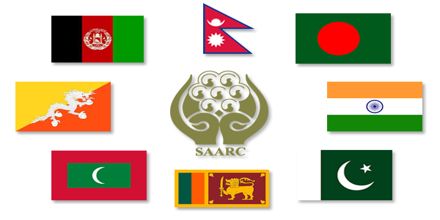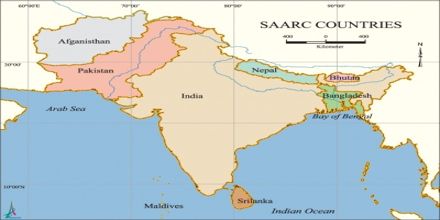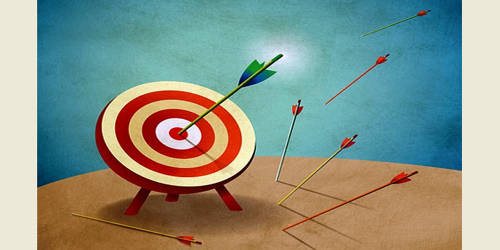The South Asian Association of Regional Cooperation (SAARC) was created in 1985 as an appearance of the region’s communal assessment to develop a regional cooperative structure. At present, there are eight member countries in SAARC namely Afghanistan, Bangladesh, Bhutan, India, Nepal, Maldives, Pakistan and Sri Lanka. It also has nine Observers, namely China, EU, Iran, Republic of Korea, Australia, Japan, Mauritius, Myanmar and USA.
Membership
Eight states― Afghanistan, Bangladesh, Bhutan, India, Maldives, Nepal, Pakistan, and Sri Lanka. Six observers—China, Japan, European Union, Republic of Korea, United States, Iran
The idea of regional cooperation in South Asia was first raised in November 1980. After consultations, the foreign secretaries of the seven founding countries—Bangladesh, Bhutan, India, Maldives, Nepal, Pakistan, and Sri Lanka—met for the first time in Colombo in April 1981. This was followed a few months later by a meeting of the Committee of the Whole, which acknowledged five broad areas for regional cooperation. The foreign ministers, at their primary meeting in New Delhi in August 1983, adopted the Declaration on South Asian Association for Regional Cooperation (SAARC) and officially launched the Integrated Program of Action (IPA) in the five agreed areas of cooperation: agriculture; rural development; telecommunications; meteorology; and health and population activities. Later, transport; postal services; scientific and technological cooperation; and sports, arts, and culture were added to the IPA. Afghanistan became the newest member of SAARC at the 13th annual summit in 2005. China and Japan were granted observer status at the same.

Purposes
The SAARC seeks to promote the wellbeing of the peoples of South Asia, build up communal self-reliance, promote active partnership and reciprocal support in various fields, and cooperate with international and regional organizations.
Every decision SAARC takes and each guidelines it frames is guided by the in general objectives it had set for itself in the charter. Although promoting “welfare economics” and “collective self-reliance” among the South Asian nations are the usually quoted objectives, yet there are some equally significant focus areas which need a mention. “Accelerating economic growth” and cultural development in South Asia is one of the priorities, which come under the broader goal of improving eminence of life.
History of SAARC
It was back in 1980 when the concept of regional political and economic cooperation in South Asia was first thought of and fired the public imagination. Even before that, the idea was discussed in three major conferences: Asian Relations Conference (New Delhi), Baguio Conference (Philippines) and Colombo Powers Conference (Sri Lanka), which were held between 1947 and 1954. Ex-president of Bangladesh, Ziaur Rahman was the one who made a official proposal on May 2, 1980. The first SAARC summit was held in Dhaka on 8 December 1985, when the organization was established. Afghanistan is the only new insertion that happened since SAARC was established.

SAARC Recognized Bodies
As an organization, SAARC principally operates through six apex bodies which ensure regional cooperation on various levels:
- SAARC Chamber of Commerce & Industry (SCCI): Its primary focus is on the holistic growth of service sector and small & medium enterprises.
- SAARCLAW (South Asian Association for Regional Cooperation in Law): This association of legal communities of SAARC nations was established in Colombo.
- South Asian Federation of Accountants (SAFA): In 1984, this organisation came into existence with an objective of strengthening and serving the accountancy profession in the South Asian Region.
- South Asia Foundation (SAF): The institutions offer courses on varied subjects ranging from Climate and Green Energy to Human Rights and Visual Arts.
- South Asia Initiative to End Violence against Children (SAIEVAC): Founded in 2005, this regional forum aims at “ending all forms of violence against children in South Asia.”
- Foundation of SAARC Writers and Literature (FOSWAL): It’s the first non-government organization working towards nurturing and strengthening cultural connectivity through interactions among SAARC nations.
Achievements & Criticism of SAARC
According to the declaration of the 16th SAARC Summit (April 2010), SAARC’s “scope and substance of cooperation had prolonged to diverse fields.” The SAARC Summits have indeed formed a platform for closed-door mutual talks exclusive to the participating nations. These meetings have somewhat led to the improvement in regional cooperation.
The scope of regional cooperation in SAARC has proliferated, and it has started to engage political, economic, social, cultural and other aspects in its dialogue. Even the member nations’ interactions with the Chambers of Commerce and Industry and the corporate sectors seem to be rising steadily.
However, SAARC is seen as a disappointment by several analysts. According to observers, it has “achieved very little” over the last three decades. Besides deteriorating regional security environment and growth of terrorism in Pakistan and Afghanistan, inter-state disputes are also a nagging concern for the grouping. Social and economic sectors have registered a dismal growth, and so is the intra-regional trade.
















